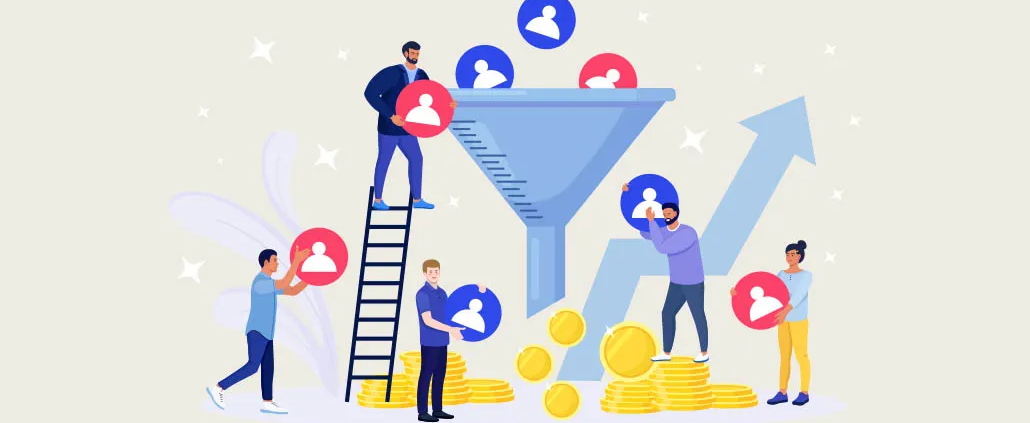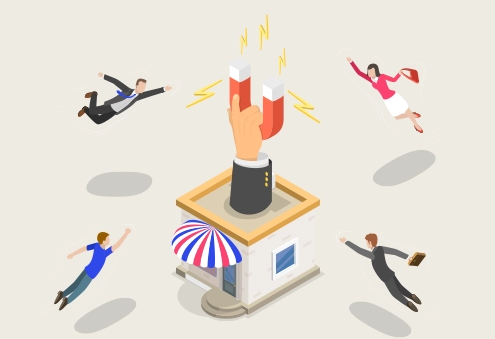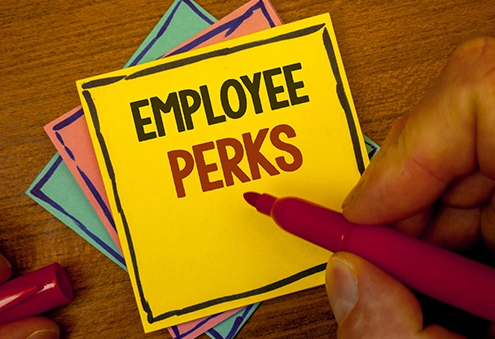What is a sales funnel?
In the world of sales and marketing, a sales funnel is an important tool for businesses aiming to convert leads into loyal customers.
A well-structured sales funnel guides potential customers through a strategic process, optimising their journey towards making a purchase.
In this blog post, we’ll explore the concept of a sales funnel, its stages, and the benefits it brings to businesses. We will also discuss how sales incentives for employees can be linked to this powerful sales strategy.
What Is a Sales Funnel?
It is a visual representation of the customer journey, showing the process of converting leads into paying customers. A sales funnel highlights the various stages a potential customer goes through, from initial awareness to the final purchase decision.
By understanding each stage of the sales funnel, businesses can optimise their marketing efforts and effectively guide prospective customers towards making a purchase.
The 5 stages of sales a funnel
A sales funnel consists of several stages that guide potential customers through their journey from initial awareness to making a purchase.
See below for what these stages include
Awareness Stage
At the top of the funnel is the awareness stage. This is where the potential customer becomes aware of your brand, product, or service for the first time. They may come across your content through various channels such as social media, search engines, referrals, or advertising. The goal at this stage is to capture their attention and generate initial interest by providing valuable and relevant information.
Interest/Consideration Stage
Once potential customers are aware of your brand, they move into the interest or consideration stage. Here, they actively seek more information and explore the benefits and features of your offerings. They might subscribe to your newsletter, download a free guide, or engage with your content on social media platforms. The focus in this stage is to nurture their interest, provide valuable resources, and showcase how your product or service can solve their specific pain points or fulfil their needs.
Evaluation/Decision Stage:
In the evaluation or decision stage, prospects have gathered enough information and are considering making a purchase. They might compare your offerings with those of your competitors, read customer reviews, or testimonials. This is the stage where you need to provide compelling reasons why they should choose your product or service over others. Offering demos, free trials or case studies can help build trust and overcome any final objections.
Purchase Stage:
The purchase stage is where the prospect becomes a customer by completing the transaction. This may involve making a direct purchase through your website or app, contacting a sales representative, or subscribing to a service. Ensuring a seamless and user-friendly purchase process is crucial at this stage to minimise the chances of abandonment.
Post-Purchase Stage
The sales funnel doesn’t end with the purchase; it extends into the post-purchase stage. Here, you focus on delivering an exceptional customer experience, providing support, and ensuring customer satisfaction. This stage is vital for developing long-term customer loyalty, encouraging repeat purchases, and generating positive word-of-mouth referrals.
It’s important to note that the stages of a sales funnel can vary depending on your specific business and industry. Some funnels may have additional stages or combine certain stages based on their unique sales process. The key is to understand your target audience, their journey, and how you can effectively guide them through each stage, ultimately leading to a successful conversion and ongoing customer relationship.
Creating a Sales Funnel
Once you understand what it is, you might be wondering how you create a sales funnel. Creating a sales funnel involves a strategic approach that aligns with your business objectives. Here are the key steps to follow:
Awareness Stage: Attracting Potential Customers
• Identify your target audience and their needs.
• Utilise various marketing channels to generate awareness and drive traffic to your website.
• Offer valuable content, such as blog posts, social media updates, and informative videos.
Interest Stage: Engaging and Capturing Leads
• Provide compelling and relevant content to capture the interest of potential customers.
• Offer incentives, such as free e-books, webinars, or product trials, to encourage lead generation.
• Use lead capture forms to collect contact information for further communication.
Evaluation Stage: Nurturing and Qualifying Leads
• Engage with leads through personalised emails, follow-ups, and targeted offers.
• Provide valuable information to educate leads about your products or services.
• Use lead scoring to prioritise and qualify leads based on their engagement level and readiness to buy.
Decision Stage: Converting Leads into Customers
• Present persuasive offers, such as discounts or limited-time promotions, to encourage purchase decisions.
• Provide testimonials, case studies, or product demonstrations to instil trust and confidence.
• Simplify the purchase process and ensure a seamless customer experience.
Action Stage: Retaining and Delighting Customers
• Provide exceptional customer service and support to build long-term relationships.
• Offer post-purchase incentives, loyalty programs, or referral rewards to encourage customer advocacy.
• Continuously analyse and optimise your sales funnel to improve conversion rates.
Putting it to practise
With the above in mind, we can now put it into practice by applying it to something as straightforward as a lemonade stand business.
Awareness Stage:
● Flyers and Signage: Create eye-catching flyers and place them strategically in the neighbourhood, on community bulletin boards, or in local establishments to inform people about your lemonade stand.
● Social Media Presence: Utilise social media platforms like Facebook or Instagram to promote your lemonade stand, sharing enticing pictures of your delicious lemonade and the location details.
● Word-of-Mouth: Encourage friends, family, and neighbours to spread the word about your lemonade stand to increase awareness in the local community.
Interest/Consideration Stage:
● Engaging Signage: Use colourful and attractive signage at your lemonade stand to grab the attention of passersby. Display information about the quality ingredients used and any unique flavours or special offers.
● Personal Interaction: Greet potential customers warmly, engage them in conversation, and describe the refreshing taste and benefits of your homemade lemonade.
● Sample Tastings: Offer small samples of your lemonade to let people experience the quality and flavour firsthand, encouraging them to consider making a purchase.
Evaluation/Decision Stage
● Pricing and Options: Clearly display your lemonade prices and any available size options, demonstrating the value for money. Offer special deals like a combo with a snack or a discounted refill for returning customers.
● Customer Testimonials: Collect feedback from satisfied customers and display their testimonials prominently at the stand to build trust and credibility.
● Visual Appeal: Present your lemonade stand in an organised and visually appealing manner, using fresh lemons, colourful decorations, and a clean and inviting setup.
Purchase Stage
● Efficient Ordering Process: Ensure a seamless and quick ordering process. Have a clear and visible menu board, accept various payment options and have a designated area for customers to place their orders.
● Upselling Opportunities: Offer additional options like lemonade refills, customised flavours, or tasty add-ons (e.g., fresh mint, fruits, etc) to increase the average transaction value.
● Provide Excellent Service: Serve customers with a smile, be attentive to their needs, and ensure prompt delivery of their orders.
Post-Purchase Stage:
● Customer Satisfaction: Ask customers about their experience and genuinely thank them for their purchase. Ensure that the lemonade meets their expectations and address any concerns or issues immediately.
● Loyalty Programs: Implement a loyalty program where customers can collect stamps or points for each purchase, incentivising them to return and enjoy more of your delicious lemonade.
● Social Media Engagement: Encourage customers to follow your lemonade stand on social media for updates on new flavours, promotions, or seasonal specials. Engage with their comments or reviews to maintain a positive online presence.
Remember to continuously assess and optimise each stage of your sales funnel based on customer feedback and preferences. By effectively guiding potential customers through this sales funnel, you can attract more people to your lemonade stand, convert them into happy customers, and establish a strong reputation in the community.
The importance of implementing a Sales Funnel
One of the key reasons why a sales funnel is important for businesses is its ability to improve lead generation and qualification. A well-designed sales funnel achieves this by:
Attracting Relevant Leads
A sales funnel starts by capturing the attention of potential customers and drawing them into your marketing ecosystem. Through targeted advertising, content marketing, social media engagement, and other lead generation strategies, you can attract individuals who are genuinely interested in your products or services. By focusing on attracting relevant leads, you can increase the chances of converting them into paying customers.
Qualifying Leads
Not all leads are created equal. Some may be ready to make a purchase decision immediately, while others require more nurturing. A sales funnel helps you qualify leads by categorising them based on their level of interest, engagement, and readiness to buy. By using lead scoring techniques, you can assign a value to each lead and prioritise your efforts accordingly. This qualification process allows you to focus your resources on leads that are most likely to convert, saving time and increasing efficiency.
Nurturing Leads
A sales funnel allows you to nurture leads throughout their journey, guiding them from initial awareness to final purchase. Through a series of targeted communications, such as email marketing campaigns, personalised content, and educational resources, you can keep your brand top of mind and provide valuable information that addresses their pain points and concerns. By nurturing leads, you build trust and credibility, increasing the likelihood of conversion when the time is right.
Identifying Barriers and Objections
As leads progress through the sales funnel, you gain insights into their interactions with your brand. This information helps you identify any barriers or objections that might be hindering their decision-making process. By understanding these pain points, you can tailor your messaging and address their concerns directly, increasing their confidence and overcoming any objections they may have. This personalised approach increases the chances of conversion and minimises potential drop-offs along the way.
Improving Lead Conversion
With a well-structured sales funnel, you can optimise each stage to maximise lead conversion rates. By strategically placing call-to-action buttons, providing clear and compelling offers, and simplifying the purchase process, you create a smooth and seamless experience for potential customers. This reduces friction and increases the likelihood of them taking the desired action, whether it’s making a purchase, scheduling a consultation, or signing up for a trial.
Reducing Sales Cycle Length
A sales funnel helps streamline the sales process, reducing the length of the sales cycle. By guiding leads through the various stages efficiently, you prevent unnecessary delays or drop-offs. With a clear path and targeted nurturing, you can move leads through the funnel more quickly, accelerating the conversion process and improving overall sales efficiency.
Benefits of a Sales Funnel
Implementing a sales funnel strategy can present several advantages for businesses including:
Improved Conversion Rates
By guiding potential customers through each stage of the sales funnel, businesses can increase their chances of conversion.
Enhanced Customer Engagement
The sales funnel allows businesses to engage with leads at different touchpoints, nurturing relationships and building trust.
Streamlined Sales Process
A well-designed sales funnel helps businesses streamline their sales processes, reducing inefficiencies and maximising sales opportunities.
Data-driven Decision Making
Tracking and analysing the sales funnel data provides valuable insights into customer behaviour, enabling businesses to make informed decisions and optimise their strategies.
Increased Revenue and ROI
A properly optimised sales funnel can lead to higher sales conversions, ultimately resulting in increased revenue and a higher return on investment.
Employee Sales Incentives the Sales Funnel Strategy
To maximise the effectiveness of your sales funnel, it is crucial to align your employees’ incentives with the desired outcomes. Consider implementing the following strategies:
Commission-based Incentives
Tie a portion of your employees’ compensation to sales targets and encourage them to drive conversions at each stage of the sales funnel.
Performance-based Bonuses
Reward employees based on their individual or team performance, considering factors like lead generation, conversion rates, and revenue growth.
Recognition and Rewards:
Implement a recognition and rewards program to acknowledge employees who excel in guiding prospects through the sales funnel. Offer incentives such as gift cards, employee of the month awards, or special privileges.
Continuous Training and Development:
Provide ongoing sales training to equip your employees with the skills and knowledge necessary to optimise the sales funnel. Encourage professional growth through certifications or workshops.
Benefits of sales incentives for the sales funnel
Sales incentives play a crucial role in motivating and rewarding employees within a sales funnel. Here are some key benefits of implementing sales incentives for employees:
Increased Motivation
Sales incentives provide employees with a tangible reward for their hard work and achievements. By offering incentives such as bonuses, commissions, or recognition, employees feel motivated to put in extra effort to meet or exceed their sales targets. This heightened motivation leads to improved performance and productivity throughout the sales funnel.
Goal Alignment
Sales incentives help align employee goals with the overall objectives of the sales funnel. When incentives are tied to specific sales targets or key performance indicators (KPIs), employees understand what is expected of them and what they need to accomplish to earn the incentive. This alignment ensures that everyone is working towards the same goals, fostering a sense of teamwork and collaboration.
Improved Sales Performance
Sales incentives provide a direct link between performance and rewards. Employees are incentivised to achieve higher sales numbers, close deals more effectively, and generate revenue for the business. By rewarding exceptional performance, sales incentives drive continuous improvement and push employees to reach their full potential, resulting in improved sales performance across the entire funnel.
Retention of Top Performers
Sales incentives can be used strategically to retain top-performing employees within the sales funnel. Recognising and rewarding high achievers not only motivates them to continue their outstanding performance but also creates a sense of loyalty and job satisfaction. Sales professionals who consistently meet or exceed targets and are consistently rewarded are more likely to stay with the organisation, reducing turnover and maintaining a high-performing sales team.
Healthy Competition
Sales incentives often introduce healthy competition among employees, which can be beneficial for the sales funnel. When individuals strive to outperform their colleagues and earn the incentive, it can lead to increased productivity and innovative sales approaches. However, it’s important to maintain a supportive and collaborative environment to ensure healthy competition that benefits the overall team dynamic.
By implementing sales incentives for employees within a sales funnel, businesses can effectively motivate and reward their sales teams, align goals, drive performance and more. These benefits contribute to the overall success and profitability of the sales funnel and the organisation as a whole.
In Closing…
Understanding and implementing a sales funnel strategy is crucial for businesses aiming to drive conversions and maximise revenue.
By understanding the stages of a sales funnel and linking sales incentives for employees, organisations can effectively guide prospects through the customer journey and achieve their sales objectives. Embrace the power of sales funnels and witness the transformation of leads into loyal customers, boosting your business growth to new heights.
Unlock your sales team’s potential and drive revenue growth with our powerful sales incentive solutions. Discover how our products can supercharge your sales funnel and boost conversions. Take action now and explore our sales incentive product page!”




